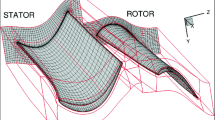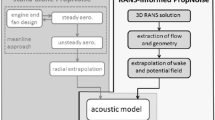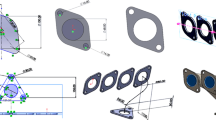Abstract
An engine exhaust manifold made of cast iron cracks during thermal shock testing. The test process is simulated by finite element analysis. The manifold is formulated as a linear heat transfer and thermoelasticity problem in a variational form. Analytical expressions for shape design sensitivities of general three-dimensional problems are presented, using the material derivative approach. A hybrid approach is described and used during the optimization process. This approach takes advantage of the direct and the adjoint variable methods and is the most efficient in calculating the sensitivity of the structural responses. After the finite element model is verified by comparing the results with those from testing, the engine exhaust manifold is optimized with respect to its geometry.
Similar content being viewed by others
References
Bennett, J.A.; Botkin, M.E. (eds.) 1986:The optimum shape: automated structural design. New York: Plenum Press
Dems, K. 1987: Sensitivity analysis in thermoelasticity problems. In: Mota Soares, C.A. (ed.)Computer aided optimal design: structural and mechanical systems, pp. 563–572. Berlin, Heidelberg, New York: Springer
Dems, K.; Mróz, Z. 1984: Variational approach by means of adjoint systems to structural optimization and sensitivity analysis II, structure shape variation.Int. J. Solids & Struct. 20, 527–552
Haug, E.J.; Choi, K.K.; Komkov, V. 1986:Design sensitivity analysis of structural systems. New York: Academic Press
Hou, G.; Sheen, J.S. Chuang, C.H. 1992: Shape sensitivity analysis and design optimization of linear, thermoelastic solids.AIAA J. 30, 528–537
Hughes, T.J.R. 1987:The finite element method. Englewood Cliffs: Prentice-Hall
Kikuchi, N. 1986:Finite element methods in mechanics. Cambridge: Cambridge University Press
Meric, R.A. 1987: Boundary element in shape design sensitivity analysis of thermoelastic solids. In: Mota Soares, C.A. (ed.)Computer aided optimal design: structural and mechanical systems, pp. 643–652. Berlin, Heidelberg, New York: Springer
Tortorelli, D.A.; Haber, R.B.; Lu, S.C.-Y. 1991: Adjoint sensitivity analysis for nonlinear dynamic thermoelastic systems.AIAA J. 29, 253–263
Vanderplaats, G.N. 1980: Comment on methods of design sensitivity analysis in structural optimization.AIAA J. 18, 1406–1407
Vanderplaats, G.N. 1973: CONMIN - a Fortran program for constrained function minimization. User's manual.NASA TM X 62 282
Yang, R.J. 1989: A three-dimensional shape optimization system- SHOP3D.Comp. & Struct. 31, 881–890
Yang, R.J. 1992: Shape design sensitivity analysis of thermoelasticity problems.Comp. Meth. Appl. Mech. Engrg. (to appear)
Yang, R.J.; Fiedler, M.J. 1987: Design modeling for large-scale three-dimensional shape optimization problems. In: Raphavan, R.; Cokonis, T.J. (eds.)Computers in engineering, pp. 177–182. New York: ASME
Author information
Authors and Affiliations
Rights and permissions
About this article
Cite this article
Yang, R.J., Poe, S.C. Shape optimal design of an engine exhaust manifold. Structural Optimization 5, 233–239 (1993). https://doi.org/10.1007/BF01743584
Received:
Revised:
Issue Date:
DOI: https://doi.org/10.1007/BF01743584




